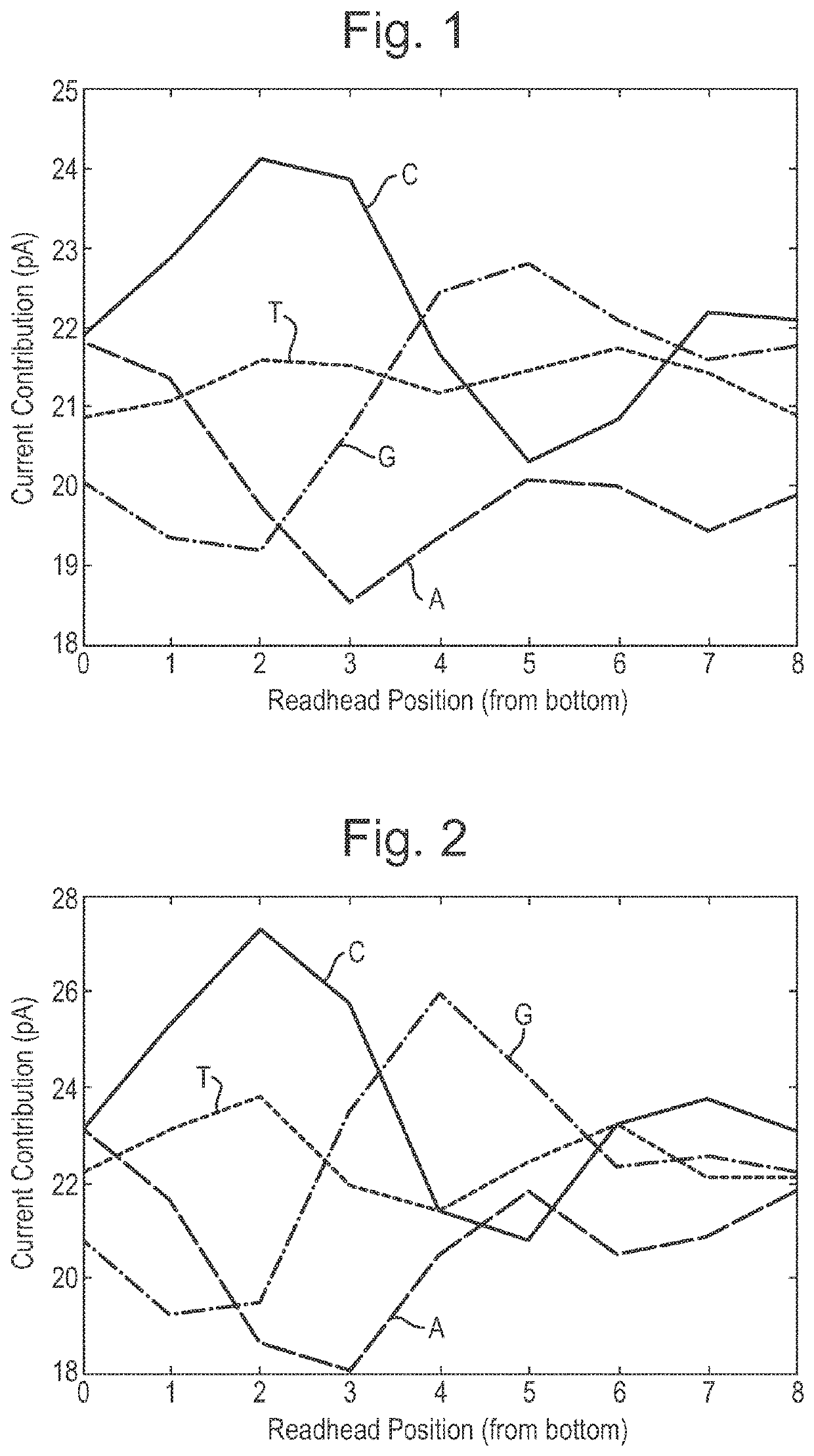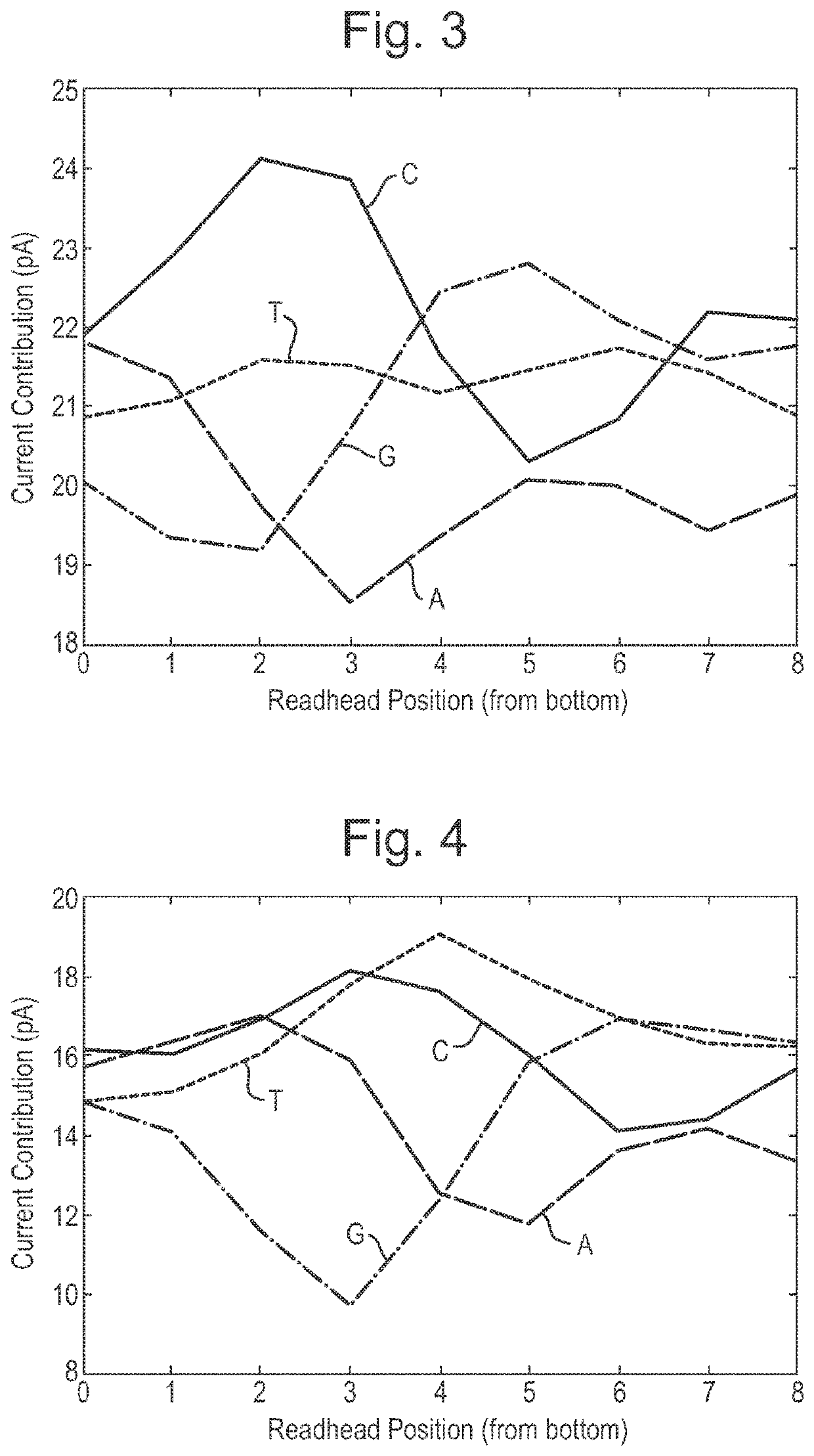Mutant pore
a lysenin and lysenin technology, applied in the field of lysenin mutant forms, can solve the problems of difficult direct relationship between observed current and polynucleotide, high variance of current state, and slow and expensive existing technologies, so as to improve the ability of monomer, improve the ability to interact, and improve the ability to estimate characteristics
- Summary
- Abstract
- Description
- Claims
- Application Information
AI Technical Summary
Benefits of technology
Problems solved by technology
Method used
Image
Examples
example 1
[0780]This example describes how a helicase—T4 Dda—E94C / C109A / C136A / A360C (SEQ ID NO: 18 with mutations E94C / C109A / C136A / A360C) was used to control the movement of DNA through a number of different mutant lysenin nanopores. All of the nanopores tested exhibited changes in current as the DNA translocated through the nanopore. The mutant nanopores tested exhibited either 1) increased range, 2) reduced noise, 3) improved signal:noise, 4) increased capture when compared to a mutant control nanopore or 5) altered size of the read-head when compared to a baseline.
Materials and Methods
DNA Construct Preparation
[0781]70 uL of T4 Dda—E94C / C109A / C136A / A360C was buffer exchanged (using a Zeba column) into 70 uL 1× KOAc buffer, with 2 mM EDTA.
[0782]70 uL of the T4 Dda—E94C / C109A / C136A / A360C buffer exchange mix was added to 70 uL of 2 uM DNA adapter (See FIG. 5 for details of sequences). The sample was then mixed and incubated for 5 mins at room temperature.[0783]1 uL of 140 mM TMAD was added and...
example 2
[0839]This example describes the protocol used to produce a chemically modified assembled pore with a reduced diameter of a barrel / channel.
[0840]Monomeric Lysenin sample (about 10 umol) was first reduced to ensure maximum reactivity of the cysteine residues and therefore high efficiency coupling reaction. The monomeric lysenin sample (about 10 umol) was incubated with 1 mM dithiothreitol (DTT) for 5-15 minutes. Cellular debris and suspended aggregates were then pelleted through centrifugation, 20,000 rpm for 10 min. The soluble fraction was then recovered and buffer exchanged to 1 mM Tris, 1 mM EDTA, pH 8.0, using 7 Kd molecular weight cut off Zeba spin columns (ThermoFisher).
[0841]The molecule that was to be attached (e.g.: 2-iodo-N-(2,2,2-trifluoroethyl)acetamide) was dissolved to a concentration of 100 mM in a suitable solvent, typically DMSO. This was added to buffer exchanged Lysenin monomer sample to a final concentration of 1 mM. The resulting solution was incubated at 30° C....
example 3
[0842]This example compared a chemically modified assembled lysenin pore with a reduced diameter of a barrel / channel (Lysenin—(E84Q / E85K / E92Q / E94C / E97S / T106K / D126G / C272A / C283A)9 with 2-iodo-N-(2,2,2-trifluoroethyl)acetamide attached via E94C (SEQ ID NO: 2 with mutations E84Q / E85K / E92Q / E94C / E97S / T106K / D126G / C272A / C283A) with Lysenin—(E84Q / E85K / E92Q / E94D / E97S / T106K / D126G / C272A / C283A)9 (SEQ ID NO: 2 with mutations E84Q / E85K / E92Q / E94D / E97S / T106K / D126G / C272A / C283A).
Materials and Methods
[0843]The DNA construct was prepared as described in example 1. Electrophysiology experiments were carried out as described in Example 1.
Results
[0844]The electrophysiology experiments showed that the chemically modified assembled pore (Lysenin—(E84Q / E85K / E92Q / E94C / E97S / T106K / D126G / C272A / C283A)9 with 2-iodo-N-(2,2,2-trifluoroethyl)acetamide attached via E94C (SEQ ID NO: 2 with mutations E84Q / E85K / E92Q / E94C / E97S / T106K / D126G / C272A / C283A) exhibited a median range of 21 pA which was greater than Lysenin—(E84Q / E...
PUM
| Property | Measurement | Unit |
|---|---|---|
| width | aaaaa | aaaaa |
| voltage | aaaaa | aaaaa |
| voltage | aaaaa | aaaaa |
Abstract
Description
Claims
Application Information
 Login to View More
Login to View More - R&D
- Intellectual Property
- Life Sciences
- Materials
- Tech Scout
- Unparalleled Data Quality
- Higher Quality Content
- 60% Fewer Hallucinations
Browse by: Latest US Patents, China's latest patents, Technical Efficacy Thesaurus, Application Domain, Technology Topic, Popular Technical Reports.
© 2025 PatSnap. All rights reserved.Legal|Privacy policy|Modern Slavery Act Transparency Statement|Sitemap|About US| Contact US: help@patsnap.com



